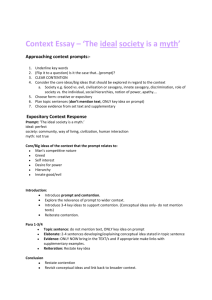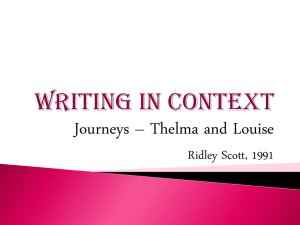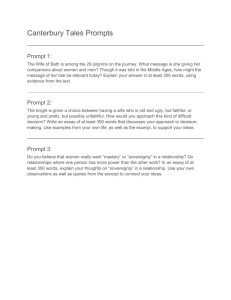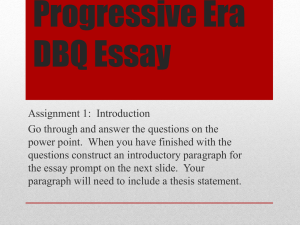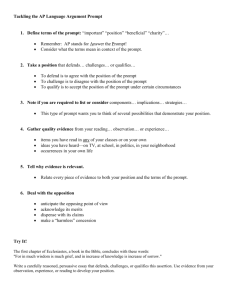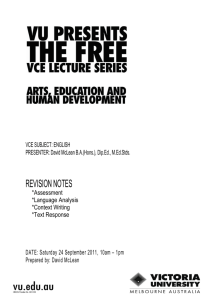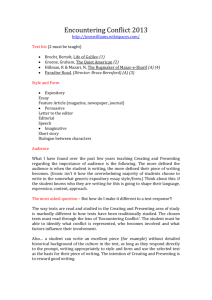Formula for language analysis and explanation of expository writing
advertisement
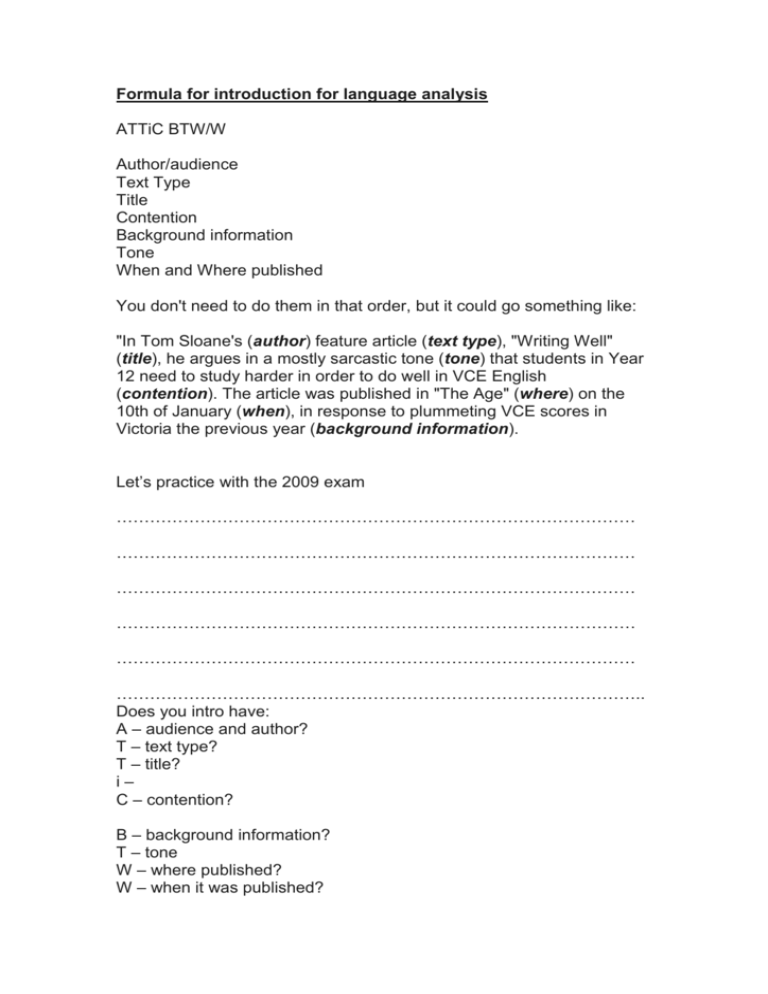
Formula for introduction for language analysis ATTiC BTW/W Author/audience Text Type Title Contention Background information Tone When and Where published You don't need to do them in that order, but it could go something like: "In Tom Sloane's (author) feature article (text type), "Writing Well" (title), he argues in a mostly sarcastic tone (tone) that students in Year 12 need to study harder in order to do well in VCE English (contention). The article was published in "The Age" (where) on the 10th of January (when), in response to plummeting VCE scores in Victoria the previous year (background information). Let’s practice with the 2009 exam ………………………………………………………………………………… ………………………………………………………………………………… ………………………………………………………………………………… ………………………………………………………………………………… ………………………………………………………………………………… ………………………………………………………………………………….. Does you intro have: A – audience and author? T – text type? T – title? i– C – contention? B – background information? T – tone W – where published? W – when it was published? Context – Expository formula KEY MESSAGES: If you read the prompt and have a really strong reaction or believe one side very strongly then you should do a persuasive essay or speech, because then you can use persuasive language techniques and get better marks for matching your chosen text type to your intention/contention. Writing an imaginative piece WELL is very difficult. Unless you have scored very highly on an imaginative piece, you should write either a persuasive or expository piece. If you're going to do an expository essay it should generally be because you recognise there are two sides to the prompt. BUT (but but but but!!!) this doesn't mean you sit on the fence or don't make a clear case. You MUST have a very clear contention that flows from the first sentence through to the last. It's more interesting to write about a variety of texts and/or world events to show the examiner you're intelligent. Here is a formula that you can use: Prompt: Landscape brings together community, rather than alienates individuals. 1) Explain what the prompt means and how it relates to the context. Make it clear you lean towards one side. (e.g. During times of crisis, groups are usually able to survive the hardship of a physical landscape (and the emotional turmoil that it inflicts) better than individuals because united the members of a group can support one another and stand strong together. However, some particularly strong individuals can survive harsh physical environments despite being alone, but this is not common.) 2) Provide a (strong) link to one of the texts studied that supports this side of the prompt (e.g. In "Tirra Lirra " we see that when characters band together into groups they are much more powerful and able to survive the harships that engulf sections of the community, such as…….)_ 3) Link this to another example (from the same text, a different text or the outside world) that also supports this side. (E.g. The ability of groups to join forces, both in a physical and emotional sense, can also be seen in the events of the "Solidarity March” to protest against violence towards women following the death of Jill Meagher, an individual who was raped and murdered in Melbourne in the spring of 2012”. 4) Link this to an example (from a text or the outside world) from the other side (e.g. On the other hand, in "Island" it is clear that lone lighthouse keeper is an extraordinarily strong individual who is able to survive alienation and isolation, even when groups around her choose the respite of family on ‘the mainland’.) 5) Provide a final example that supports the first side (from a text or the outside world) to close out your response. (e.g. However, although there are certain individuals who have the strength to deviate from the collective, many of these strong individuals are still unable to survive it or to live a life with purpose, as is also demonstrated in "Island" when the young boy suffers from displacement – stuck between the security of home and a life on ‘The Boat’ and a restlessness to strike a new tradition and identity. PLANNING YOUR EXPOSITORY PIECE Prompt: ………………………………………………………………………. ………………………………………………………………………………… ………………………………………………………………………………… Paragraph 1: Explain what the prompt means to you and how it relates to the context, also put forward your contention: ………………………………………………………………………………… ………………………………………………………………………………… ………………………………………………………………………………… ………………………………………………………………………………… ………………………………………………………………………………… ………………………………………………………………………………… ………………………………………………………………………………… ………………………………………………………………………………… ………………………………………………………………………………… ………………………………………………………………………………… ………………………………………………………………………………… ………………………………………………………………………………… ………………………………………………………………………………… ………………………………………………………………………………… ………………………………………………………………………………… ………………………………………………………………………………… ………………………………………………………………………………… ………………………………………………………………………………… ………………………………………………………………………………… ………………………………………………………………………………… Paragraph 2: Provide a (strong) link to one of the texts studied that supports this side of the prompt ………………………………………………………………………………… ………………………………………………………………………………… ………………………………………………………………………………… ………………………………………………………………………………… ………………………………………………………………………………… ………………………………………………………………………………… ………………………………………………………………………………… ………………………………………………………………………………… ………………………………………………………………………………… ………………………………………………………………………………… ………………………………………………………………………………… ………………………………………………………………………………… ………………………………………………………………………………… ………………………………………………………………………………… ………………………………………………………………………………… ………………………………………………………………………………… ………………………………………………………………………………… ………………………………………………………………………………… ………………………………………………………………………………… Paragraph 3: Link this to another example (from the same text, a different text or the outside world) that also supports this side. ………………………………………………………………………………… ………………………………………………………………………………… ………………………………………………………………………………… ………………………………………………………………………………… ………………………………………………………………………………… ………………………………………………………………………………… ………………………………………………………………………………… ………………………………………………………………………………… ………………………………………………………………………………… ………………………………………………………………………………… ………………………………………………………………………………… ………………………………………………………………………………… ………………………………………………………………………………… ………………………………………………………………………………… ………………………………………………………………………………… Paragraph 4: Link this to an example (from a text or the outside world) from the other side ………………………………………………………………………………… ………………………………………………………………………………… ………………………………………………………………………………… ………………………………………………………………………………… ………………………………………………………………………………… ………………………………………………………………………………… ………………………………………………………………………………… ………………………………………………………………………………… ………………………………………………………………………………… ………………………………………………………………………………… ………………………………………………………………………………… ………………………………………………………………………………… ………………………………………………………………………………… ………………………………………………………………………………… ………………………………………………………………………………… ………………………………………………………………………………… ………………………………………………………………………………… ………………………………………………………………………………… ………………………………………………………………………………… ………………………………………………………………………………… Paragraph 5: Provide a final example that supports the first side (from a text or the outside world) to close your response. ………………………………………………………………………………… ………………………………………………………………………………… ………………………………………………………………………………… ………………………………………………………………………………… ………………………………………………………………………………… ………………………………………………………………………………… ………………………………………………………………………………… ………………………………………………………………………………… ………………………………………………………………………………… ………………………………………………………………………………… ………………………………………………………………………………… ………………………………………………………………………………… ………………………………………………………………………………… ………………………………………………………………………………… ………………………………………………………………………………… ………………………………………………………………………………… ………………………………………………………………………………… ………………………………………………………………………………… ………………………………………………………………………………… ………………………………………………………………………………… ………………………………………………………………………………… ………………………………………………………………………………… List any quotes that you want to include from the texts or any other appropriate quotes: ………………………………………………………………………………… ………………………………………………………………………………… ………………………………………………………………………………… …………………………………………………………………………………
